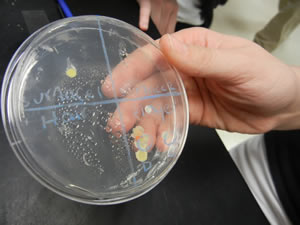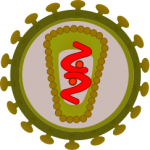When you examine the AP Biology Course Description, there is no mention of pathology (the study of diseases) in the list of Big Ideas. Bacteria are mentioned in the context of comparison between prokaryotes and eukaryotes, lines of descent, and endosymbiosis. Viruses are mentioned within the context of genetics and how DNA can be transferred from one organism to another and potentially introduce variation.

I include a pathology unit in my AP Class because lessons within this unit cover a host of topics and can apply to many of the course objectives of AP Biology. The textbook I have for the unit only has two related chapters, one on viruses and one on bacteria, but I don’t find either to be that engaging.
Instead of using this type of sequence, I have students focus on actual diseases, preferably ones that are current, and then work backwards to learn about the characteristics of the organisms that cause disease.
The Unit follows this general timeline:
Introduction:
Since this is done the first day back from winter break, I start with a simple group activity where students are asked to guess diseases after being given clues. This serves as a warm-up and way for students in the class to get to know each other. It also gives me a chance to see how much students already know about common diseases.
As an extension of this activity, I ask students to examine a list of diseases which includes basic information and to sort them into groups (Disease Sorting Activity). As a group, they will generally establish that diseases fall into three main groups: viruses, bacteria, and parasites (protists or animal). This is also a way to quickly look at a very large list of diseases that have plagued (pun intended) mankind. At the end, I ask students to pick one to focus on and design an infographic to share with the class. This is an individual project they do on their own time.
Epidemiology
Using a Case Study on the Origin of Epidemiology, students work in groups to learn how John Snow established how cholera was transmitted in London. It is a great way to review how science works and the methodology behind establishing the cause and transmission of disease. Cholera will come up again in future lessons. Students are often surprised to learn that it wasn’t that long ago that the germ theory was established. I love telling them the story of Semmelweis and child bed fever, if only to see the looks on their faces when I tell them that doctors and surgeons at one time resisted the notion that hands should be washed to prevent the spread of disease.
Focus on Diseases
After the introductory lessons, I then focus on specifics using models. Each study allows an in-depth exploration of a pathogen, the disease state, potential ways to combat the problem, and immunology. A full list of lessons, worksheets and case studies can be viewed at AP Biology / Pathology

HIV – Examine the structure of a retrovirus; focus on immunology and how the virus specifically attacks immune cells and how loss of immune function leaves the host open to opportunistic infections. Students also explore how vaccines work and why antibiotics are useless against viruses.
Ebola – Examine virus structure and discuss how modern epidemiology is used to track the source of a disease. Analyze methods used to control the spread of infectious disease.
Cholera – Examine the structure of a bacterium and explore how a bacteriophage (virus) is adapted to infect a bacterium. Students Construct a model showing the lytic versus lysogenic life cycles of a virus and compare phage treatments to traditional uses of antibiotics.
MRSA – Identify different strains of bacteria and how some strains are infectious while others are not. Review evolution in the context of bacterial reproduction. Students also prepare bacterial samples and practice laboratory techniques to ensure the safe handling of cultures.
The unit ends with students collecting bacterial samples from around the school and growing colonies on agar. Basic lab protocols are established with regard to aseptic technique and students examine known samples under a microscope. The lab includes gram staining, though mostly students learn the techniques but aren’t that successful with the actual stains. It took me an entire semester of microbiology to master that technique!

